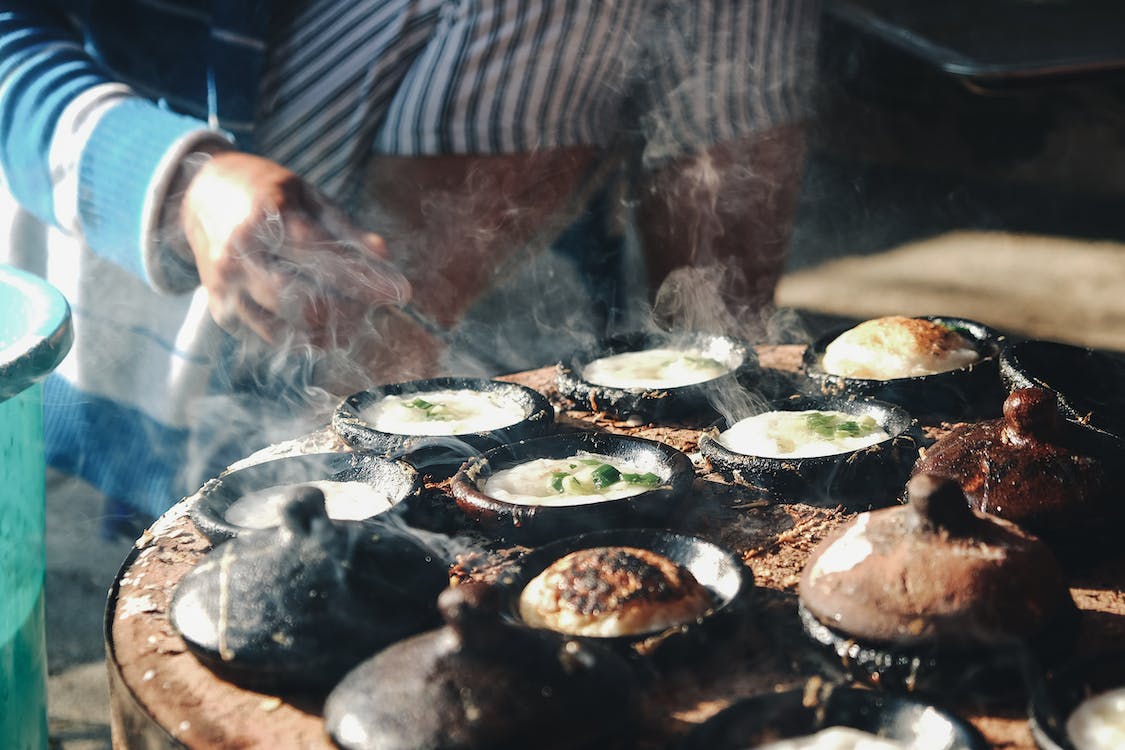Bánh tiêu, or Vietnamese hollow doughnut, is airy and light with a hollow interior, hence the name. These donuts aren’t overly sweet like the traditional western one and are usually coated with sesame seeds.
Most first-generation kids from Vietnam would probably remember the bánh tiêu as a weekend treat, exclusively sold at the local Asian supermarket. The desserts are unassumingly set on a melamine serving tray, covered with a single sheet of cling wrap to keep away the loitering flies. These donuts are usually sold at $1.50 per piece and made for the most pleasant drive home—the perfect reward after spending your morning in the chaos and hustle of the market’s busiest days.
The traditionalists often use all-purpose or plain flour for their bánh tiêu recipes, but another great alternative to this is white spelt flour that transforms the hollow doughnuts into an even fluffier and lighter pocket of pastry.
The proofing of the bánh tiêu’s dough is crucial in highlighting the pastry’s defining appearance. If the dough isn’t proofed enough, the doughnuts will be entirely hollow on the inside and lack the key fibrous textures. The perfect bánh tiêu is deep-fried golden on the outside and has slightly hollow with a honeycomb-like structure inside.
The Vietnamese hollow doughnuts are defined by their texture and, just like bánh mi (Vietnamese bread roll), highly depends on having a well-equilibrated balance between the dai (chewy) and the giòn (crispy). The dessert‘s flavors are subtle, sweet with a hint of vanilla, and slightly savory.
You can enjoy the bánh tiêu by themselves or along with other classic Vietnamese food. Try these hollow doughnuts stuffed with bánh bò (steamed rice cakes). Similar to hot chips in a sandwich with tomato sauce, it’s a pretty strange combination that you have to try for yourself and decide whether you like it or not. If the subtle flavors in red bean sesame balls or Chinese donuts are to your liking, then consider frying up some bánh tiêu and do yourself a favor of eating this delicious snack!
How to Make Bánh Tiêu
Make a tray of these Vietnamese hollow doughnuts at home with this simple bánh tiêu recipe!
Ingredients
- 1 and 1/3 cup all-purpose flour
- 3/4 tsp baking powder
- 1/4 tsp salt
- 1/2 cup 2 tbsp almond milk at room temperature (or any plant-based milk)
- 2 1/2 tbsp sugar
- 1 tsp dry yeast
- 1/2 tsp vanilla extract
- 1/4 cup white sesame seeds
- 1 1/2 cup of oil for frying
- Smooth Vanilla Chocolate Spread (OPTIONAL)
Instructions
- Whisk together the flour, salt, and baking powder in a large mixing bowl.
- In a small bowl, mix two tbsp of almond milk, vanilla extract, sugar, and dry yeast. Once thoroughly mixed, transfer to the bowl of flour and add the remaining vanilla extract and almond milk.
- Knead the dough for around five to seven minutes, or until it’s smooth and just slightly sticky. If the dough’s too sticky, add in a tablespoon of flour at a time, but if the dough’s too dry, add in more almond milk.
- Cover the dough with a plastic film to touch. Proof it in a warm place for around 1 hour and 30 minutes, or until it has doubled in size.
- Deflate the dough and cut it into six balls. Roll every ball into the white sesame seeds and flatten them into 3-4 mm thick discs.
- In a deep saucepan, pour the oil and heat it over medium heat. Once it’s hot, fry one disc at a time, flipping with two wooden spatulas or chopsticks every five to seven seconds. The disc will begin to puff up like a balloon and take a golden brown color. Once golden brown, take the pan out from the oil and place on a plate lined with a kitchen paper towel to remove the excess oil. Repeat the process with the rest of the discs.
- Enjoy the pastry warm as is, or create a cut to fill with caramel sauce or chocolate spread.
Bánh tiêu is best served on the same day you cooked it but will be fine for up to two days if stored at room temperature in an airtight container.
Recipe Tips:
- Try using active dry yeast. Be sure to use warm water to activate it.
- The dough shouldn’t be sticking to your hands. If it’s sticky, you can try adding a little bit more flour.
- The more times you flip the donuts, the fluffier they will get. Once you drop them into the hot oil, use a chopstick and continually flip the dough.
- Only fry one donut at a time.
- The dough gets dry fast, so you should cover the dough with plastic wrap.
- Use a small saucepan when deep-frying so you can use less oil.
Enjoy these Vietnamese hollow doughnuts with a cup of steaming coffee. Try filling them with caramel sauce, chocolate spread, or even a salty filling. Don’t be afraid to try different combinations!
